There are so many things to see and explore in Southeast Alaska that can only be accessed by a small boat. In 2008, my wife, Leni, and I wanted to make sure that our girls—Gracie, then three, and Isabel, then one—didn’t miss out on those things for lack of a way to get to them. That’s when we decided to build SPARROW, a Caledonia Yawl, which we launched in 2009. None of us really were sailors back then, but, lucky for us, the Caledonia yawl is a very forgiving boat.
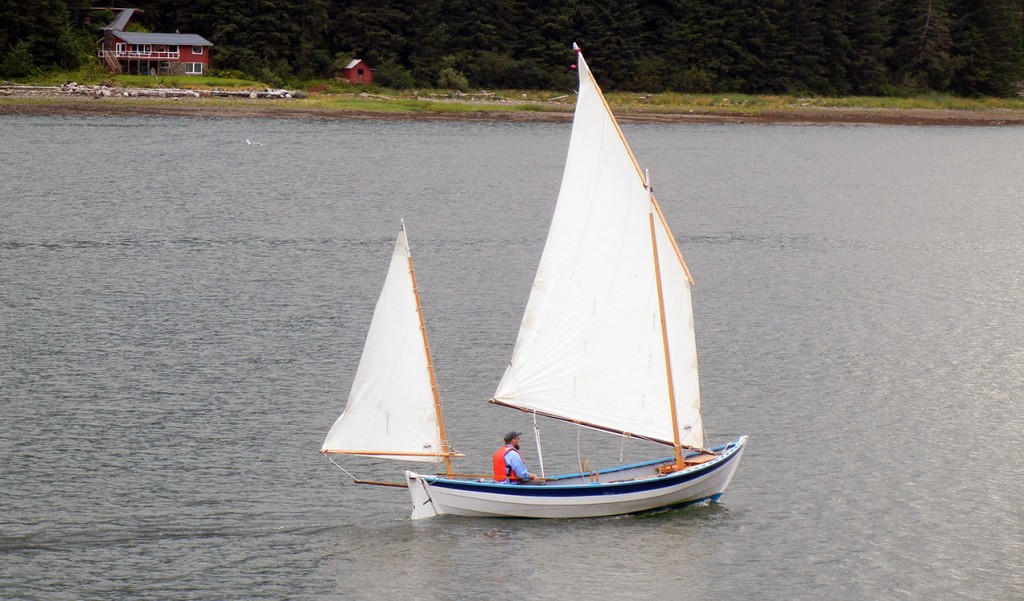 Leni Danner
Leni DannerThe Caledonia yawl’s well mannered hull and simple lug rig made it easy for us to learn how to sail.
Over the past four seasons we’ve grown into SPARROW. Our list of camping gear has been slowly whittled down each season to a more streamlined kit: shovel, axe, cook stove, small galley kit stowed in a wooden box, fishing rods, sleeping bags, and a boat tent. That made room for extra gear for the crew, enough food to last a trip six times as long as whatever we might plan, and, of course, buckets for building sand castles.
For a while, I’d been thinking about exploring some of the old mining sites south of Juneau on Gastineau channel. With the girls now eight and six, and more eager to help sail the boat, Leni and I decided to make an overnight trip with them. We planned an itinerary that would take us fewer than 10 miles down the chanel, but a world away from Juneau. Gracie and Isabel, however, were only a little curious about where we were going, and mostly eager to simply have fun, sing, and have snacks that are forbidden at home.
I watched and waited for a good weather window. When Saturday, June 29, dawned warm and fair with a good forecast for light north winds, conditions were perfect for heading south from Juneau to the mining ruins down Gastineau Channel. We’d sail against the tide, something I usually avoid, but we needed to make an exception if we were going to slip into the Treadwell mine cave-in lagoon on the incoming tide. Excavated to more than 500’ below sea level, this mine had collapsed suddenly in 1917, leaving behind the lagoon. The basin where the mine collapsed is egg-shaped and about a hundred feet across at its widest point. Sheer rocky faces on three sides drop straight into the profoundly deep green water. The Treadwell operation had once been the largest gold mine in the world, employing more than 2,000 miners. Hours before the collapse, water began to flood in through fissures in the rock, filling the mine deep below the channel. The miners escaped but some of the horses working there weren’t so lucky.
After a quick breakfast we made the short hop down to the waterfront, where SPARROW was waiting for us. Because we keep SPARROW at the dock, it took no more than fifteen minutes to stow all the gear and get the sails ready.
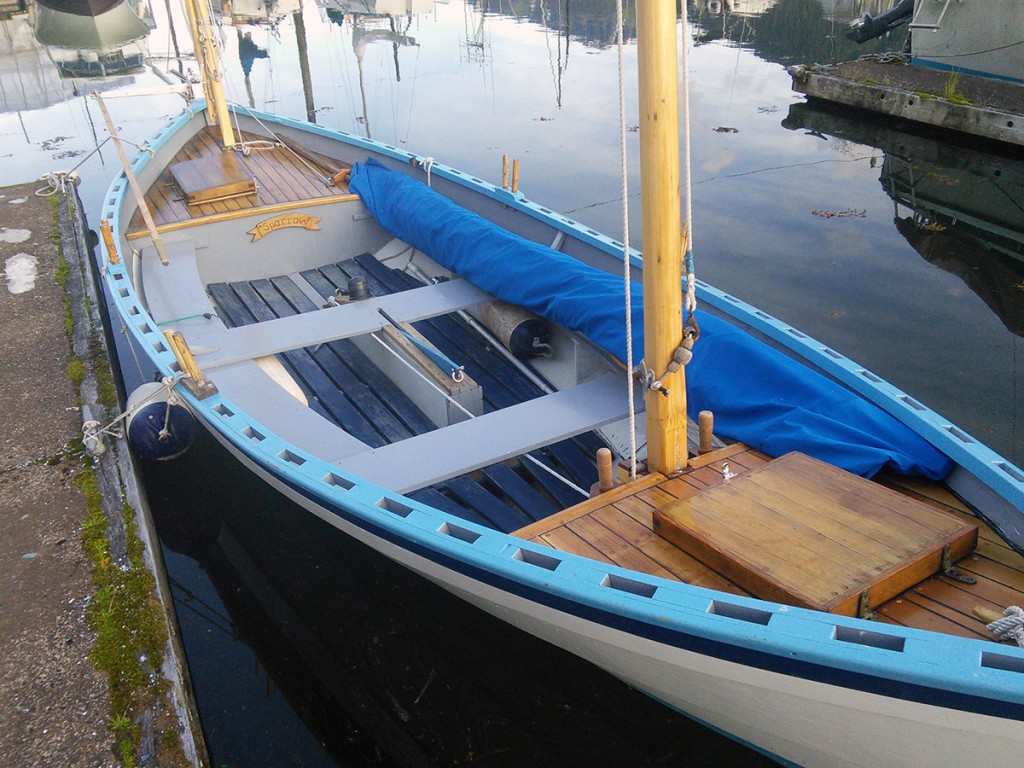 Jim Danner
Jim DannerSPARROW lies ready and waiting for crew and gear.
Away from the dock, I pulled at the oars while Leni steered us clear of the moored boats and breakwater. Safely in the middle of the channel I stowed the oars, and Leni set the mizzen and sheeted it in. SPARROW quickly luffed and sat bobbing quietly, head to wind. Gracie was keen to help and asked if she could help raise the mainsail. Isabel immediately piped up saying that she wanted to raise the sail, too. The main halyard and downhaul turn at the mast partners and lead aft to jam cleats on the centerboard trunk, allowing easy access for our young crew who, with a little help from me, soon had the sail swayed up.
With the mainsail set and the crew safely seated and enjoying granola bars, Leni eased the mizzen while I sheeted in the main. The main filled, the bow fell off, and we were on our way. We eased the sheets and came around until we were pointed down Gastineau Channel, which is approximately fifteen miles long and a mile wide at its southern end. Dense forests of Sitka spruce and western hemlock cover Douglas Island to the west and the Juneau mainland to the east, with only the tallest peaks rising above this blanket of trees. Turning to run downwind, the noise and motion of the wind were suddenly gone and we were enveloped in a bubble of still air. The shore sliding quietly by was the only sign we were moving.
Even against the tide we were making good progress and soon passed under the broad concrete arch of the Juneau-Douglas Bridge and into the outer harbor. There were four cruise ships docked there, their thousands of passengers almost doubling Juneau’s population. Float planes were making their morning rounds, five of them taking off one after another. One returning plane roared overhead, its pontoons seeming to miss the masts by mere feet.
On the far side of the outer harbor is the Rock Dump, a commercial area built upon a peninsula made of rock excavated from the mountain mines. It sticks out like a huge thumb, making the channel wide enough for only one ship to pass through at a time. Beyond the harbor things got quiet once again. Gastineau Channel opened up and only a few faraway fishing boats dotted the water. On the south side of the Rock Dump there was a wide tide rip, a dark sapphire jumble of stiff crests half a foot higher than the surrounding water. There was no avoiding it. SPARROW’s forefoot crossed the line between smooth water and dark and the current slewed us to starboard. Leni quickly corrected.
Sailing toward the rising sun on this bright morning, we all huddled in the shade of the broad lug-rigged main while the ruffled water sparkled in the sunshine. The girls, bundled up under their life jackets, were toasty warm. They held silver pinwheels spangled with red and blue stars, looking for the direction that would make them spin the fastest and giving us up-to-the-minute reports on wind direction and speed.
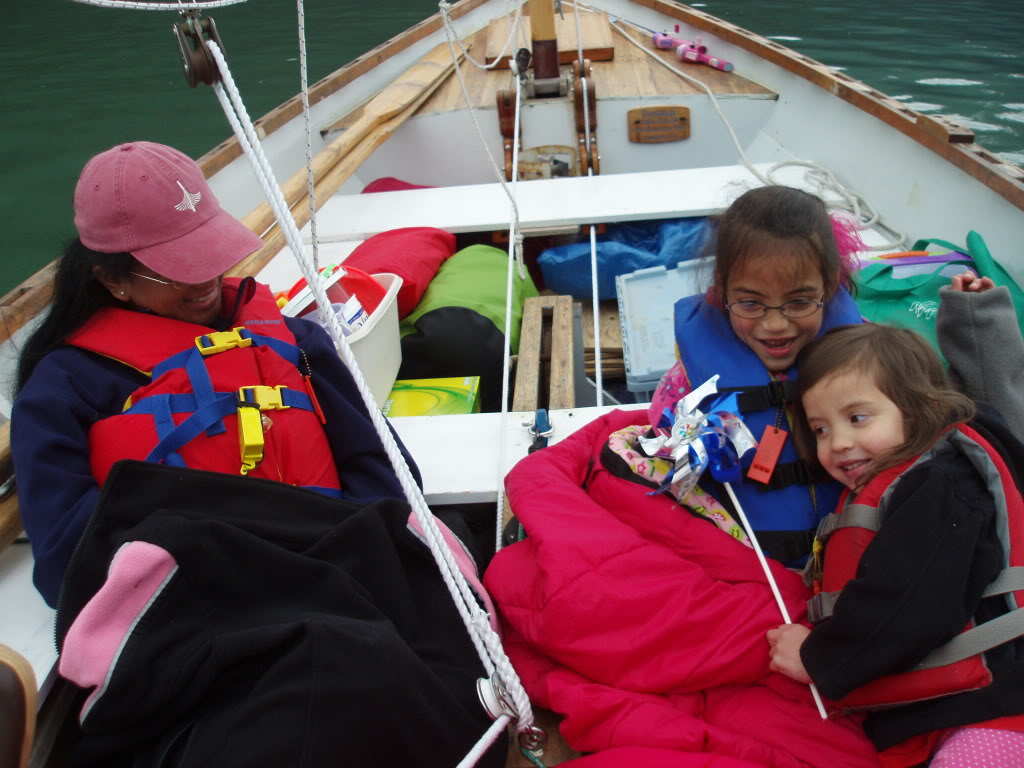 Jim Danner
Jim DannerLeni, Gracie, and Isabel, with pinwheel anemometer, take a break between weather reports.
We’d been sailing for about two hours when we reached Sandy Beach on Douglas Island and passed the Treadwell mine pump-house tower standing at the water’s edge. Its concrete base has been eroded by the tides and only the rusted iron reinforcements now hold it up. We sailed another half mile, then hove-to and dropped the main. Seated at the forward rowing station and facing forward, I pulled toward the beach as the honey-colored sandy bottom came slowly up to meet us. All the while I looked for the channel that would lead us to an emerald-green pool beyond—the sinkhole marking the half-mile deep collapsed Treadwell mine.
I followed a twisting path of darker water through the shallows; there was a rasping sound in the hull when I strayed off it and scraped bottom. The girls were talking excitedly about playing at the beach and constantly asking “Are we there yet?” We glided over the last of the bar and beached the boat.
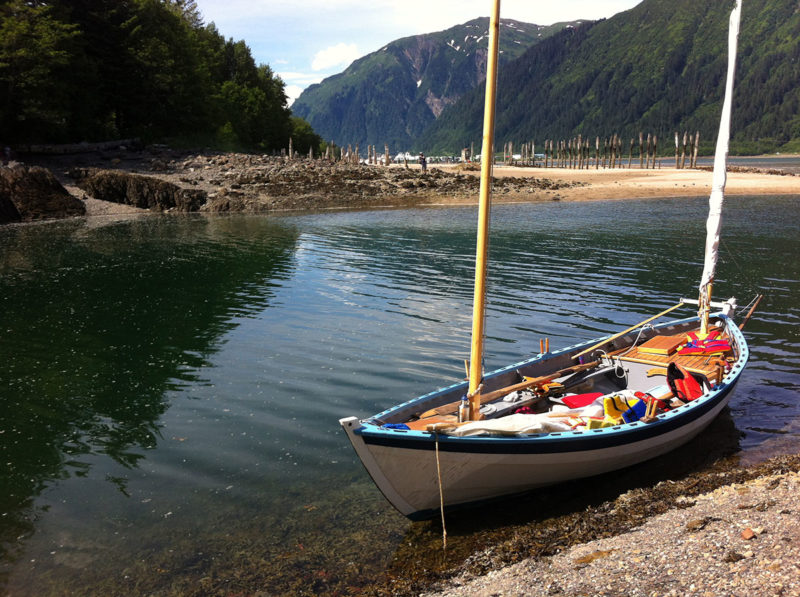 Jim Danner
Jim DannerSPARROW sits at the entrance to the lagoon.
Leni and the girls jumped from the bow to the hard packed sand with buckets, shovels, and a large canvas bag filled with sandwiches, chips, cherries, and other picnic goodies. The girls quickly fell to digging in the sand and amassed a pile of broken pottery from the old bunkhouse and tiles from the swimming pool that was once near the site of the cave-in. I tended to the boat.
Hauled up on a beach, SPARROW wants to fall over on its side. It’s not a light boat and I wanted to avoid wrestling it back to the water if the tide went out too far before we decided to move on. So I rowed across to the other side of the basin, set a grapnel on the opposite shore and then paid line out as I worked back across. Half way out I tied a loop in a bight in the line for my Anchor Buddy, a long sheathed bungee cord that stretches from 14′ out to 50′. I resumed rowing, stretching the Anchor Buddy out until I reached shore. I stepped out of SPARROW, paying out the bow line as the bungee drew her back out.
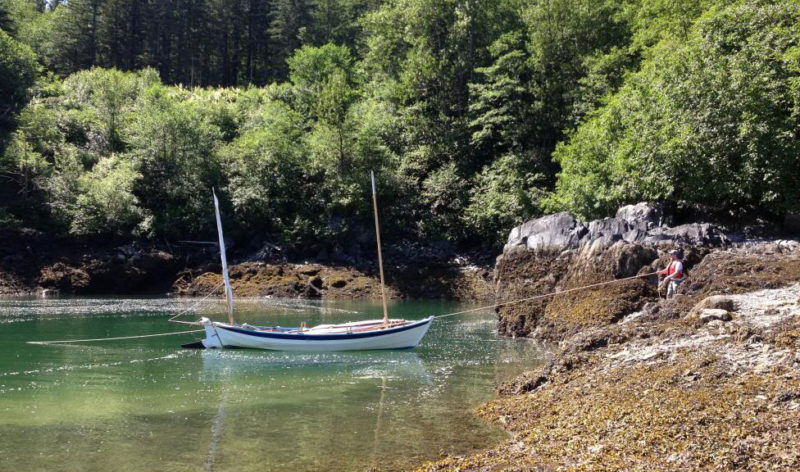 Leni Danner
Leni DannerAn elastic cord off the stern pulls SPARROW away from a rocky beach.
With the boat resting safely over deep water I joined my crew.
We settled down to a lunch of sandwiches and cherries. After eating we stowed our picnic gear and poked around the mine ruins. Just up the beach an enormous cast-iron gear about five or six feet in diameter lay half-buried in gravel looking like the face of an ancient sundial, heavily scaled with flaking rust.
Treadwell is easy to reach from Juneau and a popular place to visit. The complex is crisscrossed with hard-packed dirt trails.
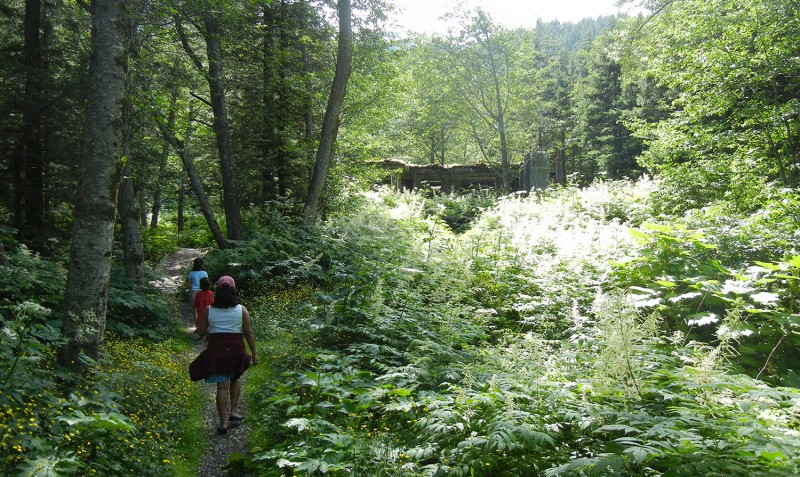 Jim Danner
Jim DannerSPARROW’s crew explores the overgrown ruins at the site of the Treadwell mines.
Down one path we found moss-covered concrete foundations, lime leaching from the concrete leaving white patches on gray slabs. The ruins of old mining structures thrust up through a dense green undergrowth of ferns and devils club like ancient temples, the wooden superstructures rotted away. Here and there old railroad tracks showed through the floor of the trail, the tops of the steel rails polished by hikers’ feet.
We came to what was once the office, a two story concrete structure with peeling yellow paint, windows and doors missing and a corrugated iron roof half rusted away. All around it are tall slender alder trees and low leafy plants. The girls were immediately drawn inside the cavernous interior where lime stalactites hang from the ceiling. They played hide and seek with Leni and me, tiptoeing behind pillars, corners, and walls. With the girls found, it was time to head back to the boat.
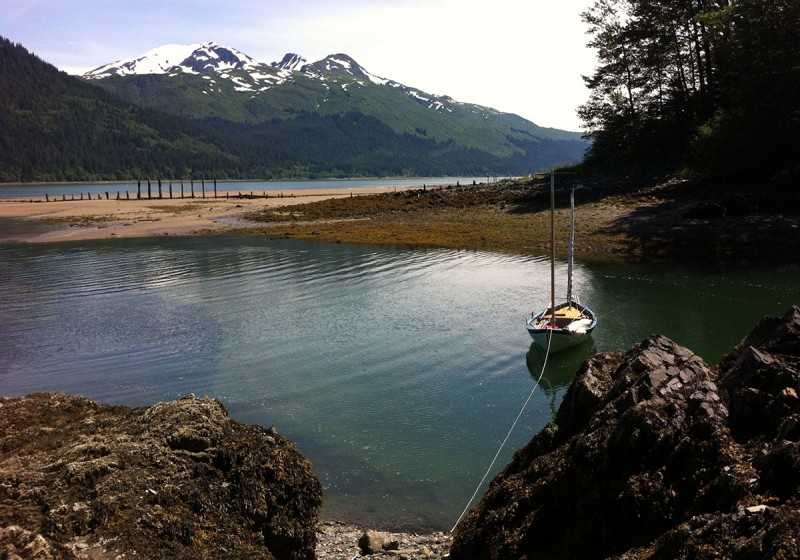 Jim Danner
Jim DannerSPARROW lies to her clothesline mooring on a falling tide.
The afternoon sky was a brassy haze and I couldn’t tell if it was overcast or not. The breeze had faded away. Isabel and Gracie were reluctant to leave but we needed to catch the outgoing tide to help us to our campsite. I pulled SPARROW ashore and we piled in and cast off. The tide had turned and that elusive channel was readily apparent now, a dark ribbon of shallow water bordered by soft sand sprinkled with palm-sized stones and white shards of broken crockery. Fortunately it was still deep enough for us to make our escape.
I poled SPARROW with an oar out of the shallows, and back out in Gastineau channel we set our sails, turned our backs to Juneau, and ran with the dying wind and ebb tide. In the distance we could see the end of the channel, where the evergreen-covered slope of Point Bishop meets the water on the left and Douglas Island does the same on the right. Beyond lay Stephens Passage, backed by high snow-capped mountains.
The plan was to camp in a little cove next to the old Dupont Dock. With a favorable current and following breeze we were moving at about three miles an hour and we’d be at our destination in two or three hours. The chill of the morning was long gone; it was a shorts-and-sandals afternoon. Gracie and Isabel succumbed to the warmth and the gentle motion of SPARROW. They curled up, one to port and the other to starboard, and were soon fast asleep.
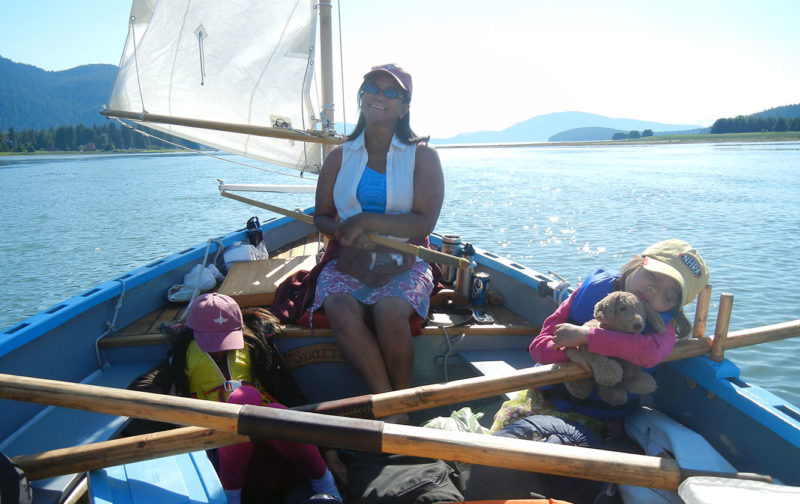 Jim Danner
Jim DannerThe girls take a well-earned rest.
Two miles down the channel the breeze faded away completely. I lowered the mainsail and took to the oars. The thunk ca-chunk rhythm of oars against thole pins filled the air as Leni steered us over glassy smooth water. A boat length behind us a dark brown head bigger than a football popped out of the water. It was a harbor seal, and it stared at us intently for almost a minute with eyes the size of silver dollars, nostrils opening and closing with each breath. It tilted its nose up, slipped beneath the surface, and was gone.
Our handheld VHF squawked to life, “Sécurité, sécurité, sécurité, this is the CARNIVAL SPIRIT departing Franklin Dock southbound Gastineau Channel.” To the north of us the upper decks of a cruise ship towering above the storage tank farm on the Rock Dump was under way. I rowed and Leni steered us south along the channel’s mainland shore. We chatted quietly about places we’d like to take SPARROW and watched the shoreline slip by. After an hour we switched places and Leni took over the rowing. CARNIVAL SPIRIT by that time was rapidly closing the distance between us. This wasn’t cause for alarm, as the channel is about three-quarters of a mile wide here with plenty of room for both of us, and we were well outside the shipping lane, a couple of boat lengths off the rocky shore on the Juneau side.
SPIRIT passed, wake creaming from its bulbous bow, white sides gleaming in the afternoon light, and tall red funnel streaming blue exhaust. The kids woke from their afternoon siesta and sat in the bottom of the boat reading books. We watched the long wake carefully as it approached us. Leni switched places with me again and took the tiller. We turned to meet the wake head on, and SPARROW’s bow rose steeply as the wave passed underneath us. I told everyone to hang on as we dropped into a 6’-deep trough. When the SPARROW hit the bottom of the trough I fully expected the bow to bury and the boat to swamp, but the boat just brushed it aside with a little splash and rode up the next wave as if it were a perfectly normal thing to do. The crew was completely unfazed: Gracie asked how much farther we had to go and Isabel asked if she could have another fruit snack. The wake crashed into the rocky shore with a roar, sending spray high enough into the air to soak overhanging spruce boughs.
The Dupont dock, owned by the Dupont Powder Company, had been used to receive explosives used in the mines. The decking of the long-idle dock is missing in places and the structure is no longer connected to the shore. What remains has accumulated a blanket of bright green moss dotted here and there with young spruce trees. Behind the dock is a steep ridge of rock about twenty feet high topped with a concrete footing where the end of the dock once was.
The current was running strong through the pilings as we rowed past, trailing little eddies around the pilings. Beyond the ridge a small cove and steep gravel beach opened up to us. As we slid into the cove and beached the boat, the girls excitedly chattered about what we might find and the prospect of camping on the boat.
I hopped out and pulled the boat up a little higher so it wouldn’t get away, then helped the girls get out. Gracie and Isabel made a beeline for the ridge of rock the old footing was on and began climbing. They had found half of a small broken egg shell that had perhaps belonged to an Actic Tern or a gull of some kind and were pretending they were sea birds nesting in the cliffs.
With the camp stove and galley box ashore, Leni got to work cooking dinner on a log high above the tide line while I pushed off in SPARROW to anchor up. Sitting in the boat and looking out at the broad expanse of Stephens Passage to the south it was hard to believe we were only seven miles from town. Here the only sign of civilization was the ruined dock and the only sounds were the kids playing on the shore. It took a couple tries to set the anchor in the loose rocky bottom; when it finally held I paid out a clothesline loop—an “outhaul”—as I rowed back to the beach.
I set up SPARROW’s tent—a dome of red rip-stop nylon stretched over crisscrossed aluminum poles—and secured it to the masts and gunwales.
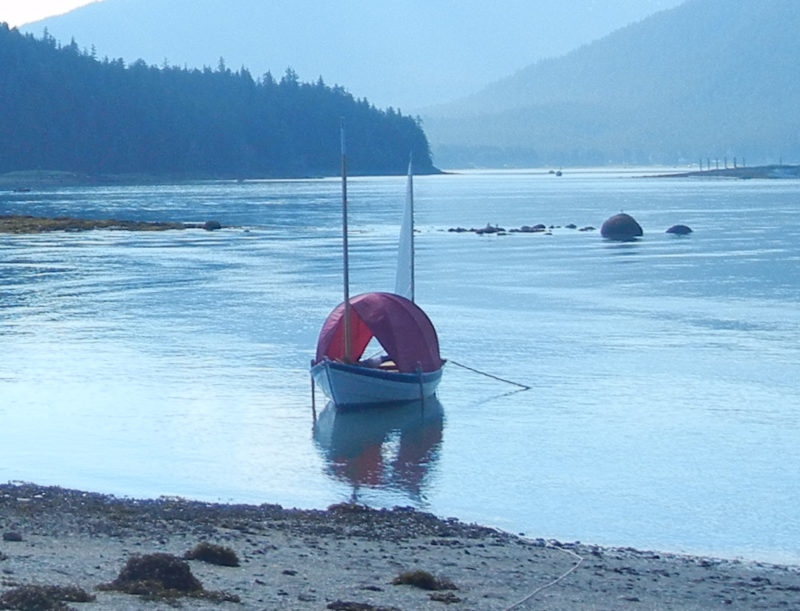 Jim Danner
Jim DannerWith her dome tent pitched, SPARROW is ready to house her crew for a night at anchor.
In ten minutes our open boat was transformed into the cozy little cabin for four, with a spot for adults on a folding platform at thwart height forward and aft, and two snug floorboard berths on either side of the centerboard case.
After a dinner of spaghetti with meat sauce and garlic bread, we cleaned up our dishes and stowed our galley kit back in the boat. Then all four of us walked together down the beach hunting for driftwood dry enough to burn. Back at camp we roasted marshmallows over a fire, then played a few rounds of the animal guessing game. Full bellies and a warm fire soon took their toll on our crew.
We put out the fire and snuggled the girls into their berths. Wrapped in sleeping bags they were dozing in minutes, and Leni soon followed.
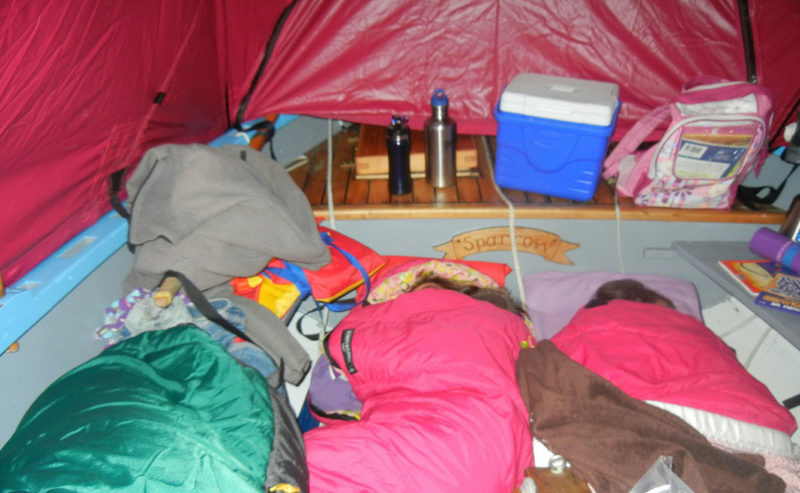 Jim Danner
Jim DannerGracie and Isabel lie sound asleep on the floorboards.
I sat up a little while longer. It was calm and quiet in our little cove, not even the water against the hull making a sound. A high overcast had worked its way in adding just a touch more darkness to the long summer dusk. Leaning against the mast, I reflected on the day. It had been a good one, full of fun and adventure on our little ship, and tomorrow was looking good too.![]()
Jim Danner is an IT manager for the state of Alaska. When he’s not working he’s spending time with his family—he and his wife recently added a baby boy to the crew—or messing around with small boats. The SPARROW is his first boat project and he has since built a few skin-on-frame kayaks. His review of the Anchor Buddy also appears in this issue.
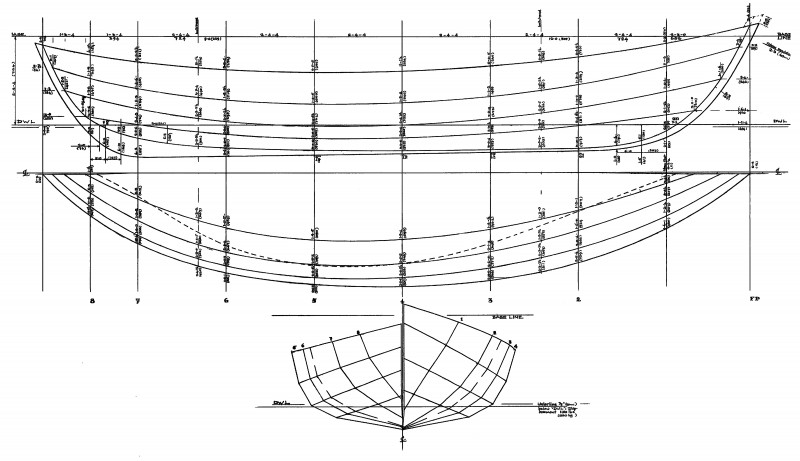
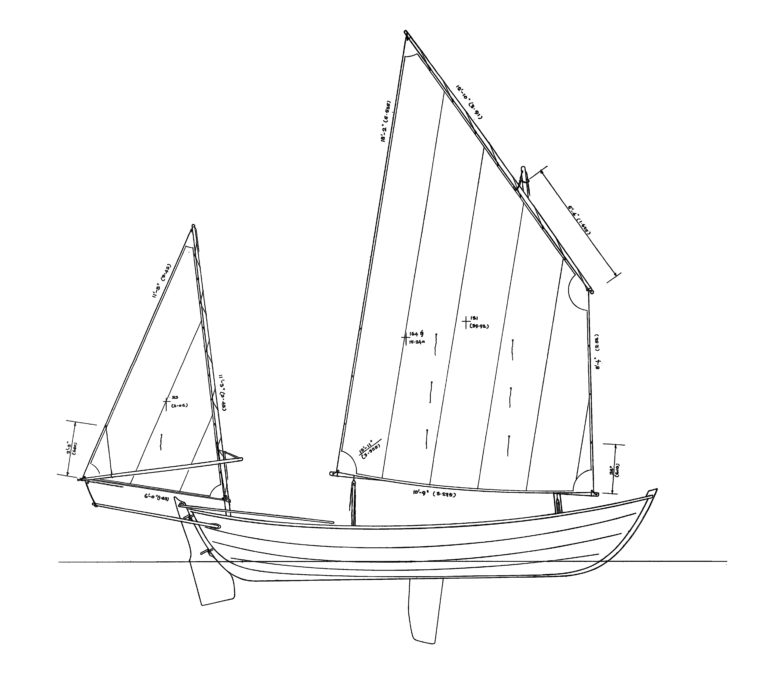
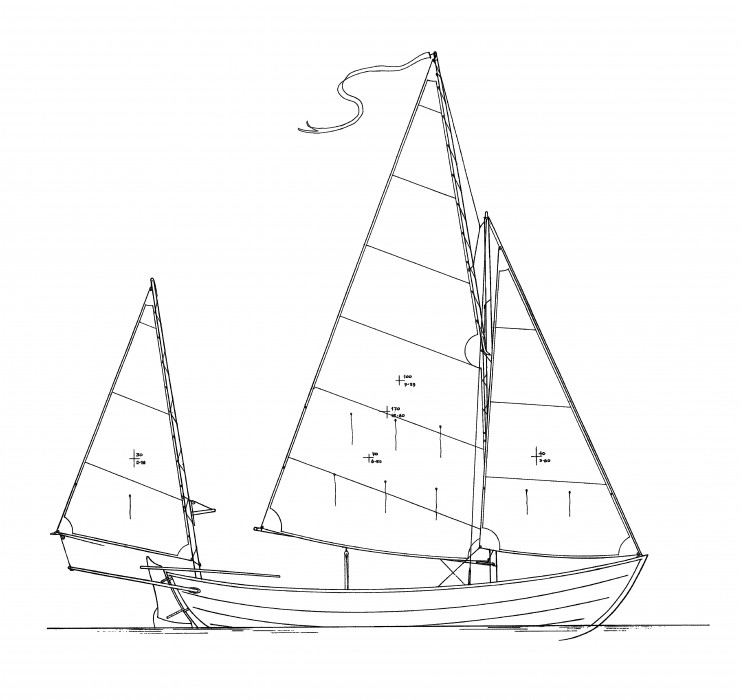
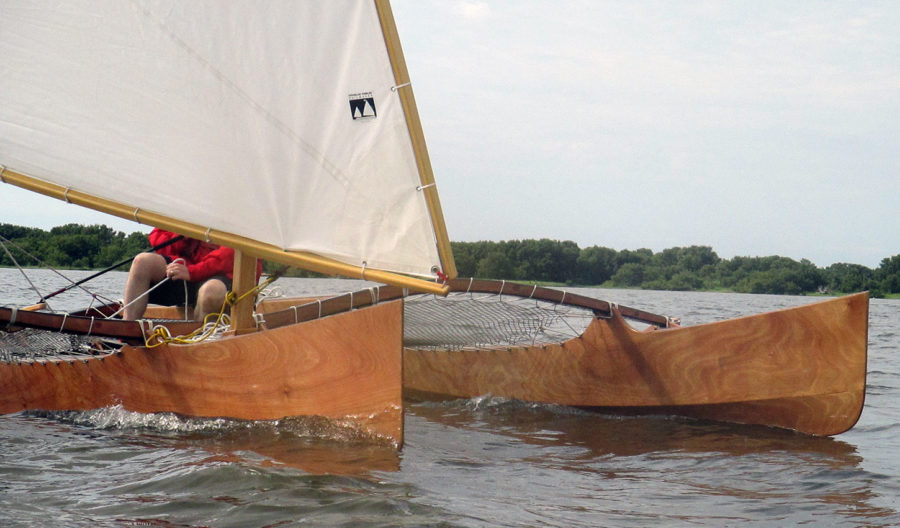
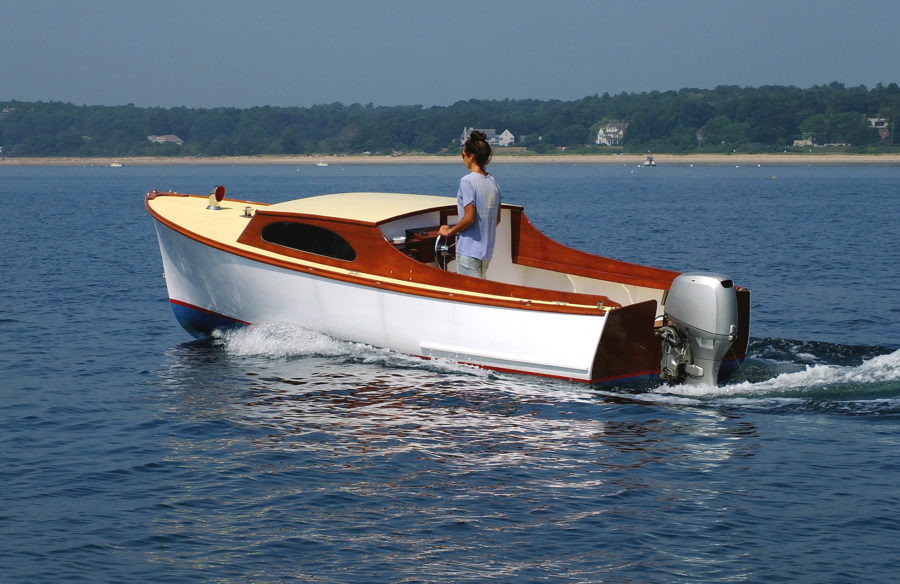
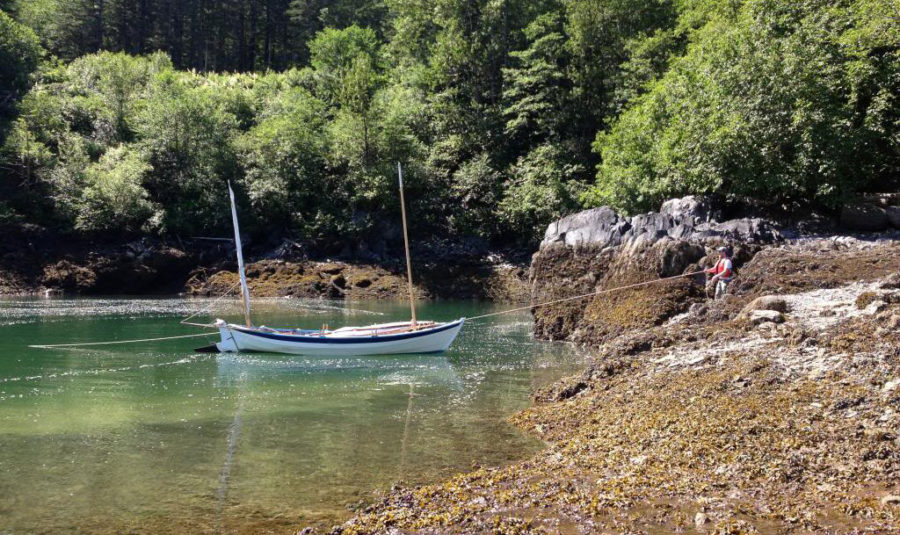
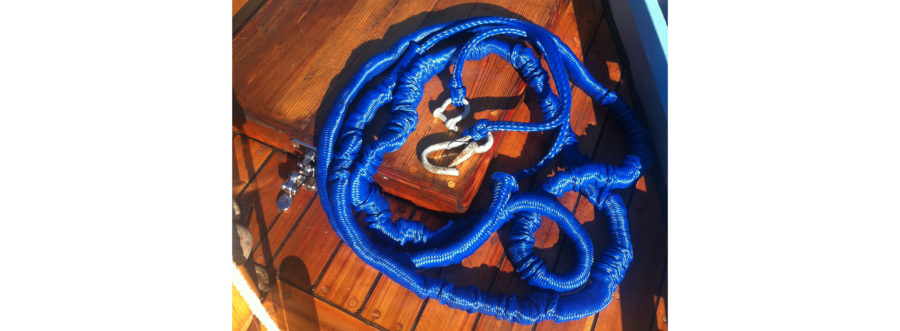
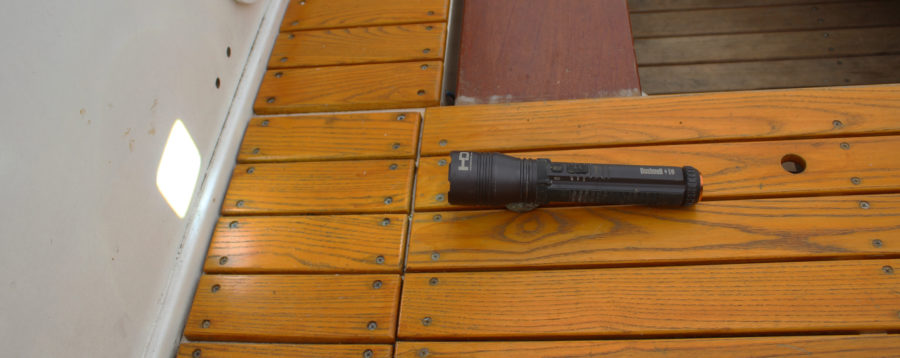
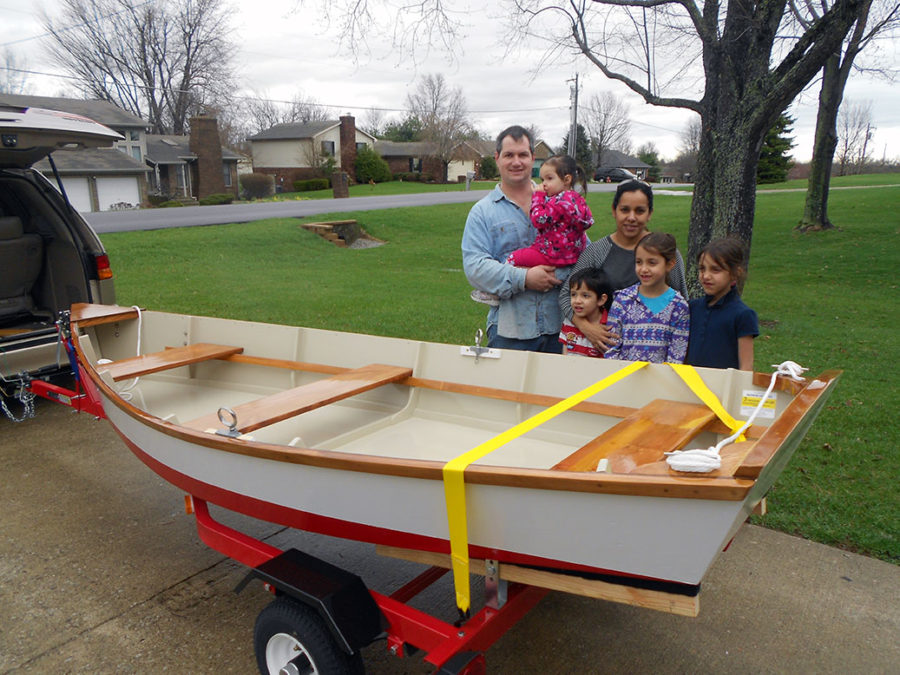
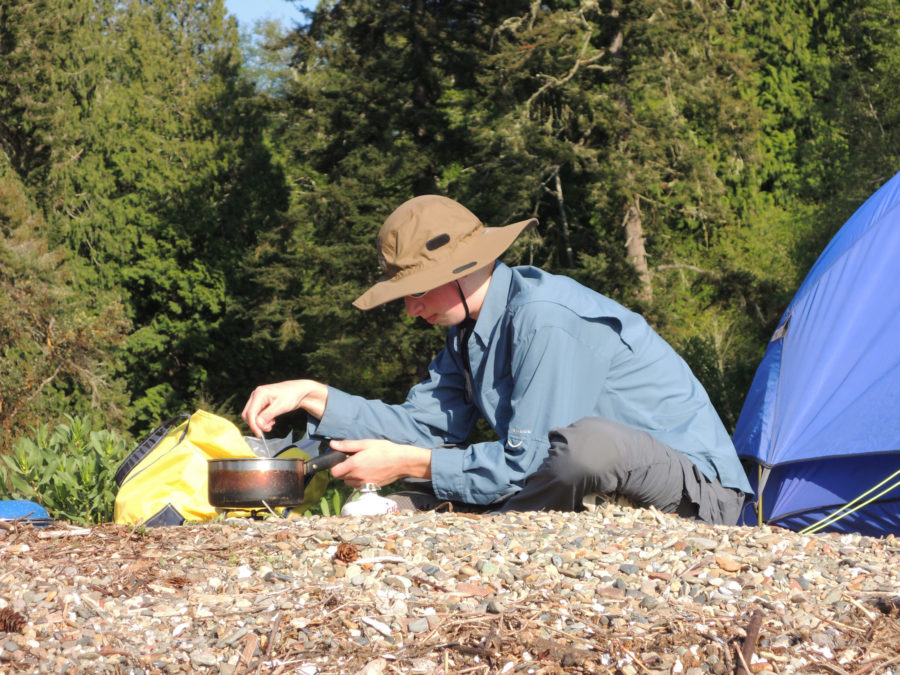

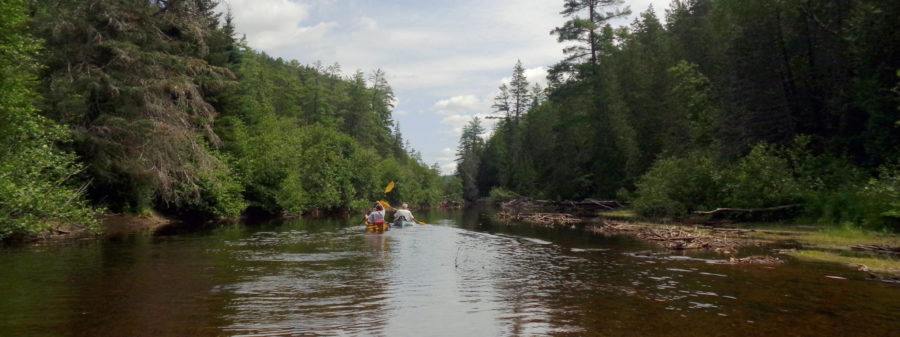
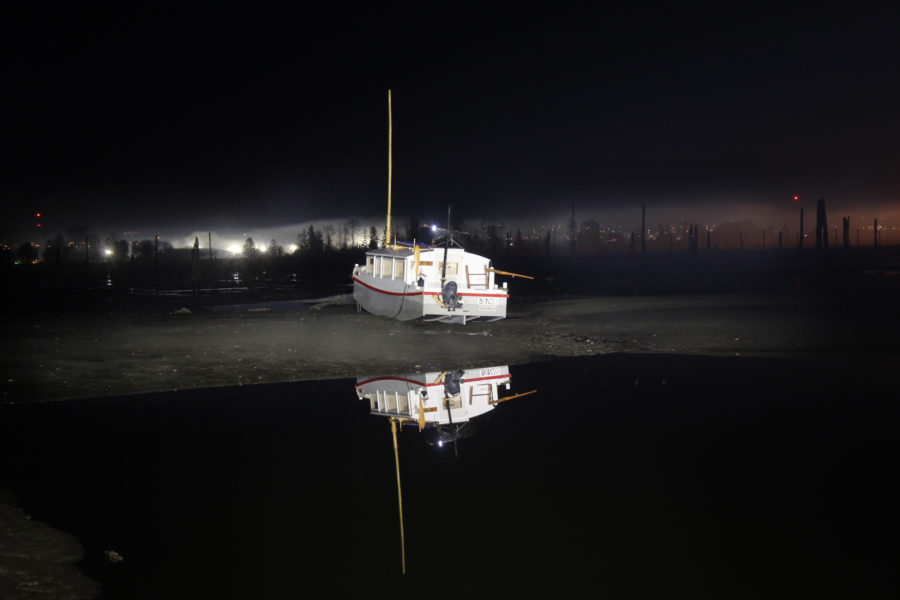
Good article! I am just getting started with my own Caledonia Yawl build so it was especially nice for me.
This was a very enjoyably story. I liked the photos, but it would have been great to see more detailed photos of the boat itself. In this particular instance having a short video to see how the boat handles would have useful as well.
I think that you are off to a good start with this new digital publication. Adding video and more embedded links would be great. I hope that you have some coverage of the Herreshoff 12 1/2 100th Anniversary races in Center Harbor in the next issue. It would nice to see at least one story on a vintage small boat like that in each issue.
Thank you,
-Dave
In our narratives you’ll get a glimpse of many interesting boats, but the details on construction, outfitting and performance are the subject of our boat profiles. In this issue the Crocker skiff and the Outrigger Junior get the close look you were hoping to find for the Caledonia yawl in Jim Danner’s article. Our companion print publication, Small Boats, now in its eighth year, has a wealth of boat reviews, but has yet to review the Caledonia yawl. That makes it a very good candidate for a review here in Small Boats Monthly. Stay tuned.
In the meantime you can find a three-part article on the construction of the Caledonia yawl in back issues 183 through 185 of WoodenBoat. There is also a review of the CY in WB 101. In the current Small Boats annual you’ll find a page by Jim Danner describing the tent he made for SPARROW. Back issues are available through the WoodenBoat Store.
Another good resource is the WoodenBoat Forum. Many threads there are devoted to the Caledonia yawl.
On a personal note, I built a CY a few years ago and modified the interior to suit my notions of cruising in comfort. There are photos and descriptions of my arrangement in the Small Boats annual for 2011. I built my CY with the same lug rig you see in Jim Danner’s story. It is quick to set up and very easy to sail. The generous sail area is great for light summer breezes and I reef that big main early if there’s more wind coming. I hope the resources I’ve listed will give you a clearer view of the Caledonia yawl. I encourage SBM readers to email me the boats they’d like to see profiled here.
Video clips are a natural for a digital publication and we’ll have them in future issues.
We weren’t able to attend the Herreshoff 12 1/2 race, but classic boats are certainly within our area of interest.
Thanks for your comments, Dave. Participation by readers is the key to making SBM a success.
Christopher Cunningham, Editor
Chris, Thank you for the thorough response and the additional links. It’s very much appreciated. Too bad you weren’t able to attend the Herreshoff 12 1/2 race as a couple of the guys from Woodenboat School’s waterfront won the races! Those a some beautiful boats.
Looking forward to the next digital issue of SBM.
Regards,
-Dave
I loved Jim’s article. He described the beauty of camp sailing well and motivated me to use my Norseboat more for the reason I obtained it. Can you share the source for the tent or did he make it himself? I am looking to extend my bimini to fill the gap to the cabin.
-J. Taylor, owner of wooden hull #1 Norseboat Cruiser
The tent Jim made for his Caledonia yawl is described in this year’s issue of Small Boats, available on newsstands and from the WoodenBoat Store. In the article “Making a Boat a Home: Six clever tents for camp cruising” WoodenBoat Senior Editor Tom Jackson takes a look at Jim’s tent and five others. In brief, the tent for the SPARROW uses aluminum tent poles for the framework and heavy-duty coated rip-stop nylon for the cover. He used plastic sheeting stretched over the poles to create the patterns for the fabric. You’ll find other approaches in Tom’s article with many details to help you get you started on your Norseboat project.
What a great story – very inspirational!
What an interesting article. I am planning to eventually build a CLC Northeaster Dory with which to explore some of Minnesota’s many lakes. This article has inspired me to hurry up and do so. Thanks
Jim, loved your story and photos. Alaska is so beautiful it would be overrun with people if the weather weren’t so bad.
+1 to the kids with pinwheels… Don’t need no stinkin’ electronic wind instruments!
Hi John,
I made Sparrow’s tent myself after looking at a few other examples I had seen on the internet. The tent really makes the kind of trips we take possible and really opens up the world of small boat cruising. As Chris mentioned, there us a write up in the most recent issue of Small Boats and there is also a thread on the Woodenboat Forum about putting the tent together. Good luck on your project.
Jim
A great article about open-boat cruising with kids and I really enjoyed it. One thing bothered me, although Jim made no mention of it in his equipment list – the absence of a firearm capable of offering protection from bears. From down here in Florida, we hear about bears on the beaches in Alaska as though they’re common as chipmunks.
I’m sure when he lands his family on the shore, Jim keeps a careful watch for any such encounters and I assume there’s really no worry when the family’s asleep on the hook. Is the threat of bears on the beach just journalistic hype (of which, as a retired newspaper writer and editor, I know about all too well), or are real precautions necessary?
Just curious. As a septuagenerian, I’ll not be sleeping on small boats in Alaska anyway!
Allan Horton
Sparrow’s gear list does not include firearms or other specific bear defense items. From my experience growing up in bear country, it is really just not necessary. The best defense against an unwanted bear encounter is a clean camp. We clean up immediately after cooking and keep unused food sealed up tight to reduce the likely hood of peaking a bear’s interest. As for feeling safe on the hook, bears are strong swimmers but I have yet to hear of one ever inviting themselves aboard an anchored boat.
But all that aside, in every bear encounter I’ve ever had the bear (or bears) have been just as interested in getting away as I was.
Jim